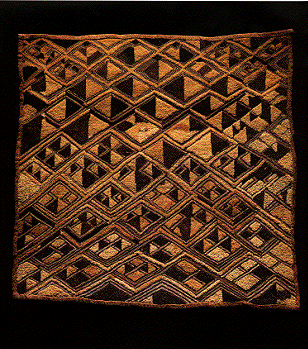
KUBA, Shoowa Textile, 23", Zaire
Photograph © John Urban
This page is a record of an exhibit that took place in 1996. The individual links below will take you to the CURRENT VERSION of the pages that formed part of that exhibit. |

"African Textiles" celebrates the many forms of traditional
cloth of tribal Africa. Throughout the exhibition it is evident the high
esteem Africans held for textiles as aesthetic expression and indicators
of wealth and status. Patterns, rhythms and color adorn an amazing range
of works. What follows is only a brief introduction to the show.
Beginning the range of groups of textiles are the relatively primitive,
abstract paintings on bark cloth made by the Mbuti pygmy. More complex are
the famous bogolanfini, the mud-dyed strip-woven cloth of the Bamana people
of Mali. Other dyed works include Yoruba adire elako, which used starch
as a painted design resist, adire oniko, which used raffia stiching to create
unique patterning, ikat, with threads tied and dyed before weaving and tie-dye
elements in Kuba works.
Patchwork and appliqued textiles abound, with selections of Asafo flags
of the Fon, long Kuba Ngeende dance dresses and full Yoruba Egungun costumes.
Embroidered works highlight traditional Hausa robes and Yoruba Ashoke cloth
from Nigeria and the wonderfully varied Shoowa "cut-pile" or "Kasai
velvet" textiles of the Kuba of Zaire.
Intricate weaving of patterns and the artistic balancing of the assembled
seperate strips create rhythmic designs in the powerfully beautiful and
deservedly much admired Kente of the Ashanti people of Ghana.. Never viewed
as a minor craft form, these hand-made textiles of Africa were worn or displayed
with pride and respect for those that made them. We share those feelings
in presenting this exhibition.
KUBA, SHOOWA TEXTILE, Zaire
These raffia cut-pile cloths, woven by men, were embroidered by women with
no stitching visible on the back. Highly prized for their inventive patterns,
they are further embellished with tight tufting, leading to the nickname
"Kasai velvet". They were sewn together for ceremonial dress,
covered royal stools, and even exchanged as currency. As a sign of status
they were buried with kings or those fortunate enough to own many.
ASHANTI, KENTE CLOTH, Ghana
Woven in narrow warp strips of silk, this textile begins and ends with a
"head" of five design blocks. The name for each Kente pattern
is derived from the warp striping, though the designs in the weft are also
significant and have names. The wearing of Kente was once the prerogative
of the king and high-ranking chiefs, but today it can be worn by other Ashanti
on formal occasions.
BAMANA, MUDCLOTH, Mali
Called bogolanfini, this strip-woven cotton textile is assembled,
then dyed with river mud and resists to create designs that are both decorative
and symbolic.
HAUSA, MAN'S ROBE, No. Nigeria
Created from strip-woven cotton cloth, this piece was joined, then embroidered
in the traditional "eight knives" pattern and several other elements
including the numerous eyelets called
"a thousand ant holes". This garment would have been used for
special occasions.
KUBA, NGEENDE DANCE DRESS, Zaire
The appliqued "patches" originally repaired holes, then developed
into traditional design motifs. Made from raffia, the long cloth, many 16-20
feet long, were wrapped around many times and worn as a skirt or dress.
YORUBA, ASHOKE TEXTILE, Nigeria
Woven in narrow strips of machine-spun cotton, this textile has sections
of openwork, with the holes linked by decorative, carry-over threads. Motifs
laid in by weft patterns are usually symbolic of stylized plants or Koran
boards.
YORUBA, ADIRE CLOTH, Nigeria
A resist-dyed cotton cloth, this piece was gathered, then stiched with raffia
thread around the folds before being dyed in indigo.
YORUBA, ADIRE CLOTH, Nigeria
A resist-dyed cotton cloth, this piece was painted freehand with starch
before being dyed in indigo.
TRIBE |
OBJECT |